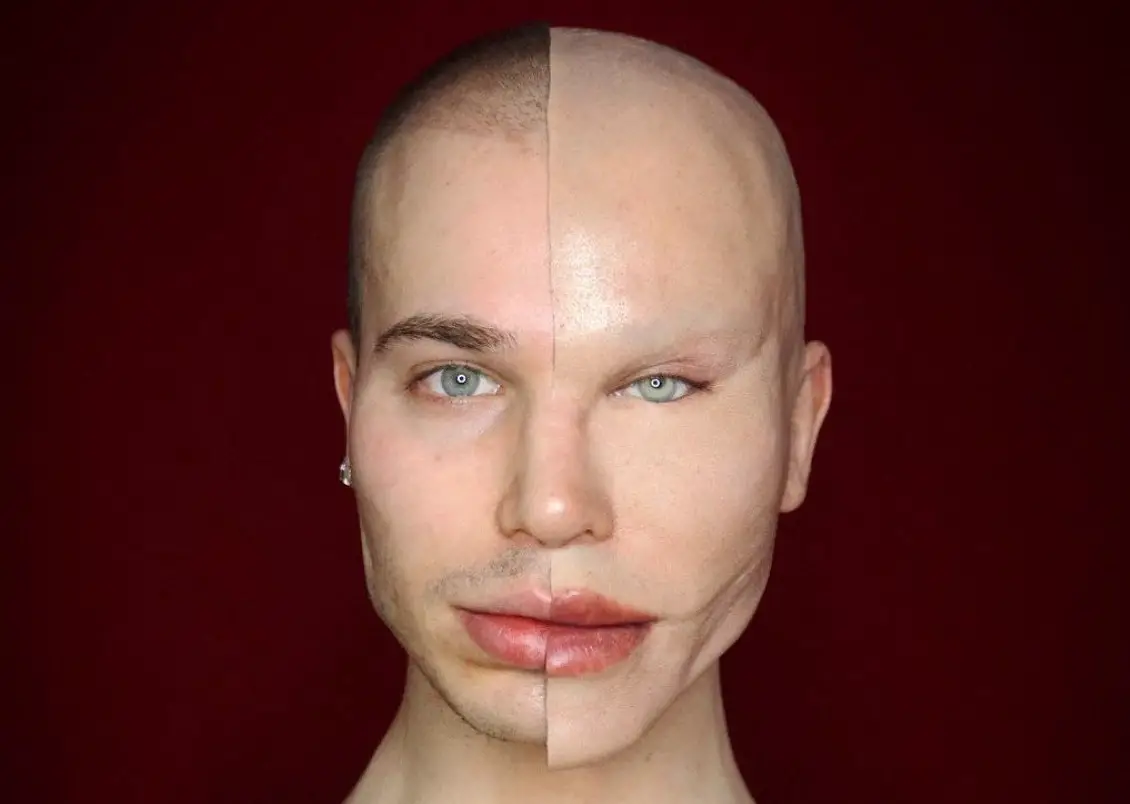Alexis Stone doesn’t look like himself.
But, the world never knew Stone as himself. A talented makeup artist and drag performer, he can turn himself into any celebrity. He’ll draw on face tattoos and a scraggly beard to become Post Malone. He contours away the majority of his jaw and adds faint crow’s feet to recreate a red-carpet photo of Jane Fonda. By chiseling his nose to nearly nothing and molding his lips to match Kim Kardashian’s distinct pout, Stone disappears beneath the face of one of the world’s most recognizable women.
In late October 2018, Stone revealed his biggest trick, his most shocking illusion yet. He announced to his 700,000 Instagram followers that he would be undergoing several cosmetic procedures at once. The announcement was accompanied by a photo of Stone wearing a hospital cap and gown with blue pen marks all over his face, indicating where the incisions would occur. He had previously spoken about getting minor procedures done. Nothing serious, just small efforts to course correct nature: fillers in his lips and cheeks, a little Botox. But this time was different.
This was not a transformation for Stone, the chameleon, the face that could turn into anything and snap right back. This was the transformation of Elliot Joseph Rentz, the person underneath it all.
A month later, Stone revealed his new face. He was nearly unrecognizable, his features taking on the strain of several years’ worth of plastic surgery procedures done in one day. The change was extreme, and so was the response. His comments flooded with expressions of shock and horror. They wondered, how could he do that to himself? At 25, he had wasted a handsome and, more importantly, youthful face, and what kind of psycho would do that? More than a few commenters suggested he just go ahead and kill himself.
https://www.instagram.com/p/BpCoK22nx2e/
He lay low for the next few months, reappearing only occasionally to post a drag look reminiscent of his oft-cited creative inspirations Jocelyn Wildenstein and Priscilla Presley, as well as Joan Collins in “Dynasty.” Then, in the soap opera that had become Stone’s public narrative, he managed an eleventh-hour twist: On New Year’s Day, he tore his face off.
Standing alone in a padded room, Stone puffs on a cigarette as the lights begin to strobe and the image distorts. His hand moves toward his hairline. His wig topples over as he rips away the prosthetics that had served as his public face for the past few months.
The reveal was posted to his YouTube channel in a video entitled “The Stone Age,” which also functioned as an announcement for Stone’s collaboration with cosmetics brand The Creme Shop. Another video followed in which Stone documented how he executed the project, including commissioning prosthetics from David Marti, an Oscar-winning special effects makeup artist. Marti also provided Stone with stunt masks designed for him to wear whenever he left his home.
Stone embodied the project to the point that it had spilled over into his daily life, but what was it all for? What was the point of convincing the world he had ruined his face?
It was never meant to be anything. Just a prank, a couple of Instagram posts before it disappeared into the internet’s ether. He had become fed up with the judgmental comments he received after speaking openly about his fillers and Botox, so he decided to poke the bear. The face could come off at any time, but he just wanted to see what would happen, how people would react. Stone’s new face was designed to elicit a reaction, but he had underestimated the fury of an angry mob on the internet. When he revealed the results of his “surgery,” he didn’t just poke the bear, he stabbed it and twisted the knife.
His prank had morphed into something different. In interviews following the reveal video, Stone says he started to view the project as a “social experiment,” one meant to highlight the hypocrisy of lofty beauty standards and the ire met by those who try to meet them. “All it took was a little bit of silicone stuck to my face and a storyline to sell the narrative,” Stone told Paper Magazine. “I was turned into a meme, I became the butt of everyone’s joke.”
Stone’s experiment was still far from bulletproof. The harsh judgements faced by people who are open about plastic surgery were hard to deny, but it was also difficult to entirely sympathize with Stone. Following the reveal, Stone implied that the project had created seemingly irreparable damage to his career and reputation. Despite this, following the release of his The Creme Shop-sponsored video, Stone gained more than 16,500 Instagram followers back. The day after, he gained back nearly 13,000 more. Stone may be saying something completely valid about beauty standards and its warped relationship with cosmetic surgery, but he did it with the security of someone who could remove the mask and bounce back.
In an interview with Vice, Imp Queen, a Chicago-based drag performer, said, “It seems disingenuous for him to knowingly produce this storm of hatred about extreme beauty/‘botched’ face work, and then act sanctimonious about how cruel people were to him from the safe position of his conventional cis white male beauty.”
But still, the same people who applauded him whenever he painted his face into a beloved celebrity were the same voices berating him for transforming into something else, somebody they couldn’t recognize. Stone had always trafficked in the images of other people, but the interjection of his own life and insecurities proved to be too much. His followers loved the art, but they couldn’t love the artist.
It is no secret that social media exists as artifice, especially on the commercialized level that Stone and many of his peers operate on. While the world may clamor for authenticity, all that is truly expected and desired is curated perfection. Stone had evoked a narrative that was too real, the story of someone unsatisfied, of someone who had grown unhappy with his looks. The standards of perfection are constantly moving. Stone could try chasing them with makeup, but the act of permanently altering his appearance would simply turn him into something unrelatable, unnatural and unreal.
In his openness about his cosmetic procedures, both the real and the fabricated, he had broken the protective barrier created by his username. He had punctured the immaculate fantasy he had produced for his followers, and he had upset them. His truthfulness was frightening, and they wanted to revert back. The world wanted the old Alexis Stone. The world wanted the person who could become anyone.
















